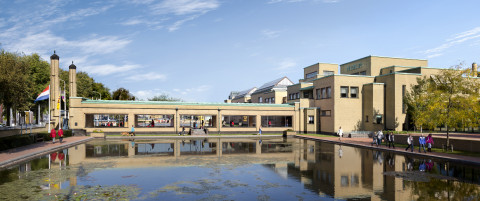
Plan your visit
Visit the Kunstmuseum The Hague. See our openinghours, entrance fees and read about other practical info.
Kunstmuseum Den Haag has a treasure chamber of over 160.000 pieces of art. Here we work on making the highlights from this collection available online.
Kunstmuseum Den Haag’s new visual identity includes a striking ‘K’ that is in keeping with the Hague typographic tradition. It has been designed by Peter Bil’ak, who drew inspiration from the museum’s collection of graphic works. Typotheque – What You Hear When You Read will provide a glimpse of his design process. It will include the first sketches for the Kunstmuseum’s new typographic logo, and a small cross-section of work by Typotheque, the studio that Bil’ak has run with Johanna Bil’ak and Nikola Djurek since 1999. Their clients include international companies like Facebook, Google, Mozilla, Vienna International Airport and the Paris metro.
Biľak has been fascinated by the ‘personality’ of typefaces ever since he studied at the art academy in Bratislava. ‘Like people, typefaces all have their own character, and give words and language a certain voice’, he explains. ‘They embody meanings that go further than simply the design of the printed material. A typeface can express ideals and subtle emotions, whisper things between the lines.’
Collaborating with dancer and choreographer Lukas Timulak, Biľak and his studio Typotheque also literally bring their designs to life in a remarkable mix of dance, music, graphic design and technology. The exhibition will include film of two of their choreographies, plus footage never seen before featuring interdisciplinary dance performances for the Royal Ballet in Stockholm and the National Theatre in Brno.
'Like people, typefaces all have their own character, and give words and language a certain voice.'
The idea for the new typographic logo for Kunstmuseum Den Haag came from the museum’s collection of graphic works. Biľak drew inspiration from the typography of the 1920s and 30s, the period when the museum was designed and built by architect H.P. Berlage. This was a period of great innovation in art and design, when designers, artists and architects shook off the decorative forms of the nineteenth century. Typographers introduced simple sans-serif typefaces that reflected the new age. The experiments were an international trend, but several Dutch designers played a pioneering role. They included Piet Zwart (1885-1977), Gerard Kiljan (1891-1968) and Paul Schuitema (1897-1973). Inspired by Russian constructivists, they set out to find new forms of expression in words and images. Their work – often referred to as New Typography – is well represented in the museum’s collection.
About Peter Biľak and Typotheque
Peter Biľak (b. 1973, Czechoslovakia) and his studio Typotheque design typefaces and logos that are used all over the world. Besides commissioned work, the studio also publishes its own work, which includes books and magazines as well as typefaces. Two well-known titles are Dot Dot Dot (2000 to 2010) and Works That Work (2013 to 2018), English-language magazines on graphic design and visual culture.